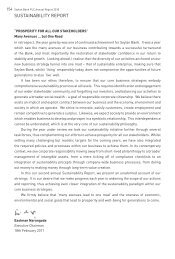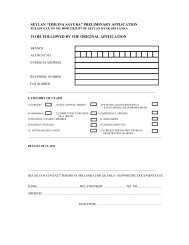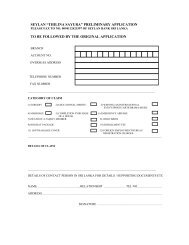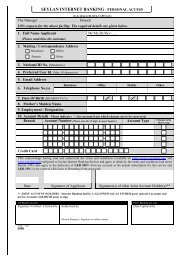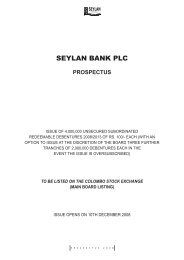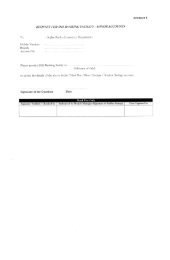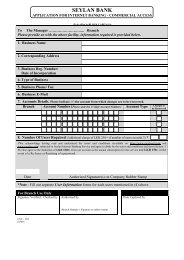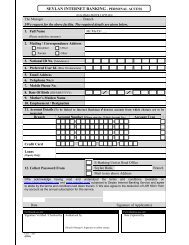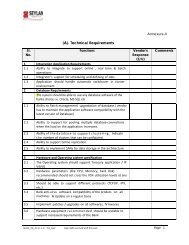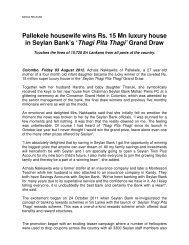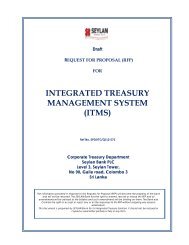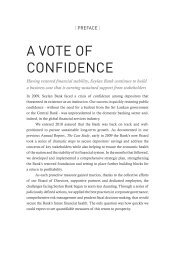The Case Study - Seylan Bank
The Case Study - Seylan Bank
The Case Study - Seylan Bank
Create successful ePaper yourself
Turn your PDF publications into a flip-book with our unique Google optimized e-Paper software.
<strong>Seylan</strong> <strong>Bank</strong> PLC Annual Report 2009 159Notes to the Consolidated Financial Statementsmismatches in the re-pricing periods of assets and liabilities and an approach of minimising the gaps andlimiting long-term fixed rates is followed by the <strong>Bank</strong>.<strong>Seylan</strong> as a policy does not carry a significant exposure to the equity market whilst of course being anactive investor within applicable prudential limits.<strong>The</strong> different types of market risks and the Balance Sheet structure with a long-term focus are monitoredby the Asset and Liability Management Committee (ALCO).(f) Operational RiskOperational risk refers to the losses arising from fraud, negligence, oversight, human error, process errors,system failures, external events, etc. <strong>The</strong> <strong>Bank</strong> manages most elements of the operational risk through soundinternal control systems and well-defined processes both technology driven and with human intervention.<strong>The</strong> areas of risk include process risks where faulty processes or errors in the processes could triggerlosses. Continuous review of the systems and the processes either on a regular review basis or pursuant toobserved loss events and incidents addresses potential weaknesses of the processes.In implementation of new products that invariably relies on technology as well as human involvement arisk review is an essential aspect that needs both the marketing objectives as well as the risk managementrequirements. <strong>Bank</strong> strives to subject such new product introductions to adequate review.<strong>Bank</strong> also maintains its policies with regard to access control and data protection and necessarysafeguards are constantly introduced and upgraded to ensure the integrity of the information and the databases. Preventive measure such as firewalls and virus guards among other steps are put in place.(g) Capital ManagementCapital Adequacy is a measure of a commercial bank’s ability to withstand the associated risks of its business.Regulators find it necessary that every bank holds adequate capital to absorb unexpected losses as a goingconcern, while they price their products and services to take care of expected risks. Capital Adequacy Ratio(CAR) was measured on the basis of credit and Market risk under the BASEL I accord and under BASEL IIit takes into account the credit, market and operations risks. Keeping with the International Standards ofBASEL Committee on <strong>Bank</strong>ing Regulations and Supervisory Practices, Sri Lanka has been following BASEL IICAR calculation from January 2008 after conducting parallel calculations in 2007.(g.I) Available CapitalBasel I and Basel II accords recognise three capital elements, namely, Tier I, Tier II and Tier III capital. TierI capital includes paid up ordinary share capital, paid up non-cumulative, non-redeemable preference shares,share premium, statutory reserve fund, published retained earnings, general and other reserves less goodwill.Tier II capital includes 50% of asset revaluation reserves (created by revaluation carried out in every sevenyears) general provision for advances, hybrid debt/equity instruments and approved subordinated term debts.Tier II capital cannot exceed Tier I capital and subordinated debt cannot exceed 50% of the Tier I capital.Tier III capital will consist only of short-term debt instrument and will be used for calculation of market riskonly. Tier III is subject to a maximum of 250% of Tier I capital after meeting the credit and operational risk.Equity investments in unconsolidated banking and financial subsidiaries and investments in capital ofother banks/financial associates are deducted from capital in arriving at the capital base. <strong>The</strong> <strong>Bank</strong> isrequired to maintain a minimum total risk-weighted capital ratio of 10% in respect of Domestic <strong>Bank</strong>ingUnit (DBU) and Foreign Currency <strong>Bank</strong>ing Unit (FCBU) operations.



